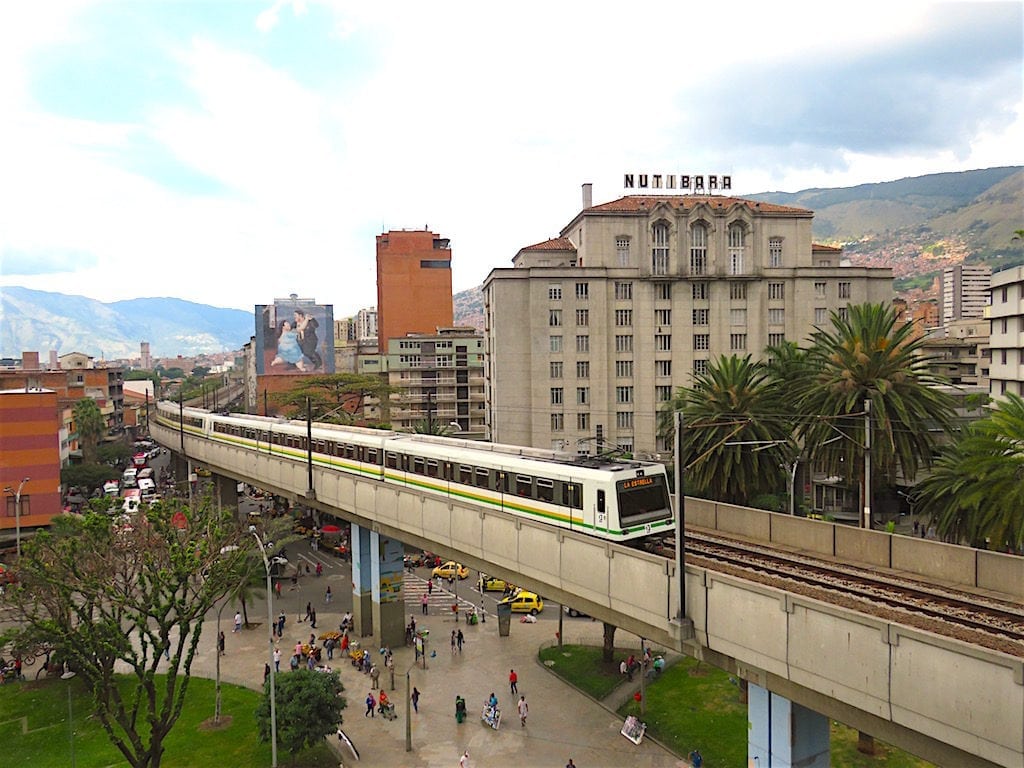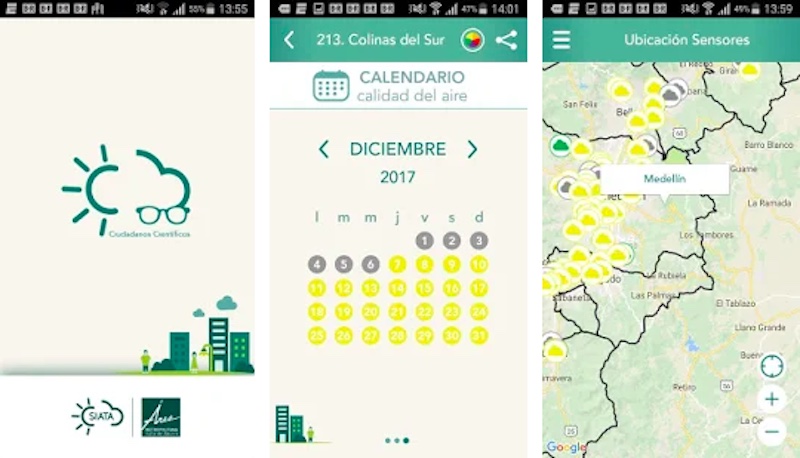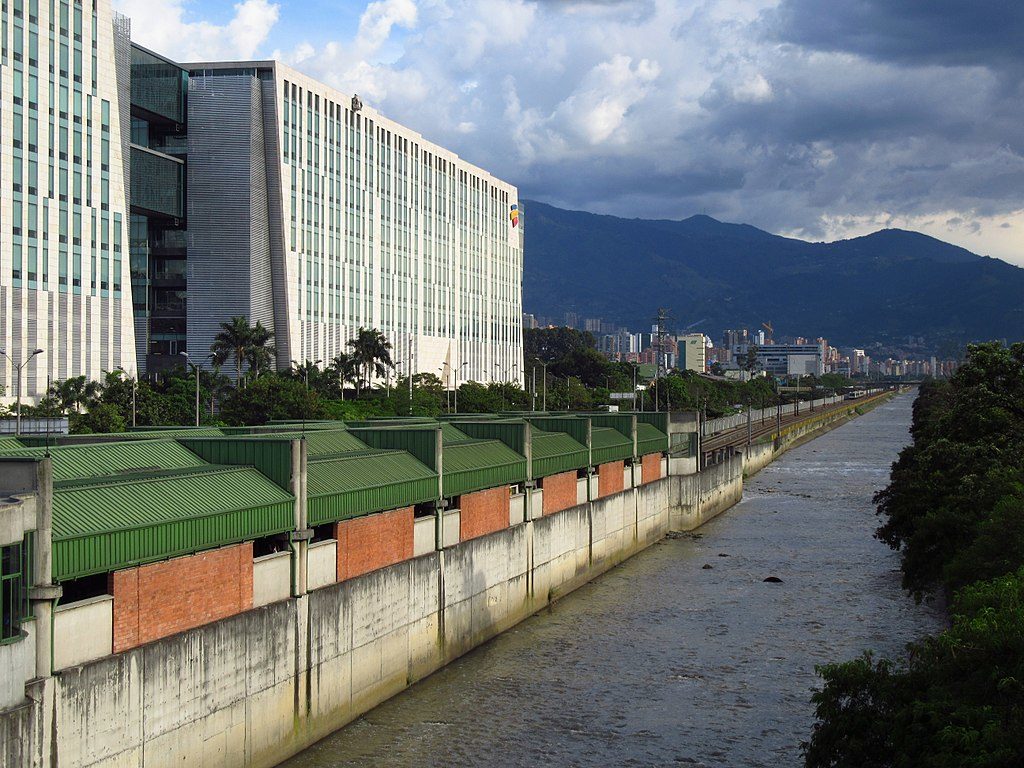Pollution in Medellín is a major concern of expats living in Medellín or considering moving to the city. Pollution is a downside of living in Medellín.
I have seen numerous comments about pollution in Medellín posted on blogs and Facebook groups. Examples of comments include “Medellín has some of the worst pollution on earth” and “pollution in Medellín is the worst I have experienced”. But in many cases these comments are inaccurate.
However, pollution is one of the downsides of living in Medellín, which was included in a list of 11 downsides of living in Medellín.
According to the World Health Organization’s (WHO’s) 2018 Ambient Air Quality Database, Medellín is ranked #9 out of the most polluted cities and towns in Latin America based on PM2.5 pollutants. Medellín’s location is in a canyon with mountains surrounding the city. This does not allow for easy dispersion of pollutants.
So, pollution generally stays in the metropolitan area. This is similar to the problem found in Denver. However, regular rain in Medellín can help clean the atmosphere.
Note the above photo is pollution in Medellín during a “red” alert in March 2017.
Pollution is one of the downsides of living in Medellín but there are many benefits including the climate, cost of living and good healthcare. I previously covered 27 reasons why I chose to live in Medellín.
Medellín Pollution: The Pollution Facts
Medellín does not have some of the “worst pollution on earth” as some expats appear to think. According to WHO’s database, there are over 330 cities and towns in the world that have worse pollution than in Medellín.
And the worst pollution in the world is actually found in India and China with over 260 cities and towns in these two countries with worse pollution than Medellín.
Also, according to WHO, in Latin America several cities and towns have worse pollution than in Medellín. Lima, Peru; Monterrey, Mexico; five towns in Chile; and Guatemala all have worse air pollutant problems.
In addition, Bogotá in Colombia has a similar pollution problem to Medellín, as Bogotá is a large city that is also surrounded by mountains.
Medellín Pollution: Geographic Location Contributes to the Problem
Medellín is located in the Aburrá Valley and is surrounded by mountains. This creates an adverse geographical condition for the horizontal circulation of air masses. And when combined with poor ventilation conditions (adverse weather) this contributes to the accumulation of pollutants and makes their removal difficult.
In the Aburrá Valley, the characteristics of meteorology and climatology frequently change due to:
- Being located in the tropics
- The topography
- The possibility of high humidity
- External forces
These forces combine to modulate the atmospheric stability within the Aburrá Valley, which affects the ventilation and the removal of pollutants by dispersion and convection.
Furthermore, in the Aburrá Valley, there normally are two periods each year with higher levels of air pollution, which is determined by meteorology.
In March each year is typically the transition between the dry season and the first rainy season, which is characterized by the presence of layers of low-lying clouds, which cause the accumulation of pollutants in the atmosphere. And this is when the highest concentrations of particulate material (PM10 and PM2.5) of the year typically occurs in Medellín.
And in September each year is the second transition between the dry season and the rainy season when an increase in the concentrations of particulate material is typically seen.
Medellín Pollution: Particulate Matter (PM) Pollution
Particulate matter pollution, aka PM, is the term for a mixture of solid particles and liquid droplets found in the air. Some PM, such as dust, dirt, soot and smoke, are large or dark enough to be seen with the naked eye. And others are so small they can only be detected using an electron microscope.
The EPA in the U.S. regulates two categories of PM for health and welfare reasons. And these two categories are used in pollutant monitoring systems used throughout the world:
- PM10 – are coarse and inhalable particles, with diameters that are generally between 2.5 and 10 micrometers.
- PM2.5 – are very fine and inhalable particles, with diameters that are generally 2.5 micrometers and smaller
Medellín typically has more of a serious problem with PM2.5 and less of a problem with PM10. PM2.5 primarily comes from combustion from vehicles (cars, buses, motorcycles and trucks) and from fires and emissions (releases) from power plants and industrial facilities.
PM10 comes from a variety of sources including dust from roads, farms, dry riverbeds, construction sites and mines.
Medellín Pollution: Smog “Seasons” in Medellín
Medellín normally has two smog “seasons” each year. This happens when the climate transitions from the dry season to the rainy season in March-April and in September-October each year. This is due to cooler and denser air sitting atop rising warm air, which traps pollutants in the Aburrá Valley.
During the March-April 2016 smog “season”, citizen groups took to the streets of Medellín including Aire Medellin, Bicitertulia, Ciudadanos por el Aire, La Ciudad Verde, Low Carbon City, Siclas and Túnel Verde and called for air quality data for Medellín to be published.
This pollution awareness campaign in 2016 resulted in air quality data being made publicly available online. In addition, the regional government began coordinating a comprehensive air quality management plan in collaboration with citizens, academia, the private sector and local and national authorities in 2017.

Main sources of PM2.5 contaminants in Medellín, source: AMVA-UPB 2015
Medellín Pollution: Main Sources of Contaminants
The majority (79 percent) of the PM2.5 contaminants in Medellín reportedly comes from vehicles and only 21 percent comes from fixed sources such as power plants, as seen in the above figure.
Between 2005 and 2015, the number of vehicles in the Aburrá Valley increased 182 percent from 478,000 in 2015 to 1.35 million in 2015.
The biggest increase from 2005 to 2015 was in motorcycles, which increased 411 percent from 139,000 motorcycles in 2005 to 710,186 motorcycles in 2015. And there are now more motorcycles than cars and taxis in Medellín.

The Medellín Metro in El Centro
The Medellín Metro system transported over 298 million passengers in 2018, which was an increase of 3.8 percent from 2017. If Medellín did not have its metro system, the pollution problem would be much worse in the city with many more vehicles.
Medellín Pollution: Medellín Has a Comprehensive Air Quality Management Plan
Medellín and the Aburrá valley has one of the most comprehensive air quality management plans in Latin America.
In 1998, the Aburrá Valley launched the Program for the Protection and Control of the Air Quality from the Metropolitan Area of the Aburrá Valley, which was the first metropolitan air quality management plan, issued in 2008.
But a new plan was developed in 2017 by the Aburrá Valley Metropolitan Area in collaboration with the Clean Air Institute, an international organization with significant experience in air quality management.
This plan was approved by the 10 mayors of the Aburrá Valley Metropolitan Area in December 2017. The plan is known as the “Comprehensive Air Pollution Management Plan” (Plan Integral de Gestión de Contaminación del Aire) or PIGECA.
According to Juan J. Castillo, Director of Environmental Health at the Clean Air Institute, about the PIGECA plan:
It is one of the most comprehensive plans in the Latin American region, with concrete goals, abatement strategies and commitments from all sectors, with a communication strategy threaded through.
This plan includes a key goal to transform towards a low emission mobility system, which includes:
- Expansion, connectivity and integration of the infrastructure network for bicycles.
- Promotion of bicycle use through the availability of the Encicla public bicycle system.
- Encourage the use of public transport like the Medellín metro.
- Discourage the use of a private vehicles.
From January to August in 2018, Medellín only experienced one “red” alert day due to high pollution. This was down from 30 in 2016. And some in the city council saw that as evidence that PIGECA was working.

February 2019 vehicle restrictions due to pollution, courtesy of Area Metropolitana Valle de Aburrá
Medellín Can Restrict Vehicles During Times with High Pollution
Medellín has a major problem with pollution during two times of the year during the transition from the dry season to the rainy season. Every time there is a transition between the dry and rainy seasons, clouds prevent the particulate material PM2.5, which is harmful to health, from being released into the atmosphere
So, the 10 municipalities in February 2019 have entered into a state of prevention due to the quality of the air that is breathed in the Aburrá Valley during this time of year. The above restrictions go into effect on Monday, February 18, 2019.
The restriction based on license plates is for private vehicles, freight vehicles, two and four-stroke motorcycles. The schedule in which the restriction is in effect in the 10 municipalities of the Medellín metropolitan area is in the mornings from 7:00 to 8:30 am and in the afternoons from 5:30 pm to 7:00 pm.

Ciudadanos Cientificos App, courtesy of SIATA
Medellín Pollution: Pollution Monitoring
Under Colombian law, all cities and towns with a population greater than 50,000 or where a problem of air pollutants is evident must have a pollution monitoring surveillance system in place.
Medellin and the Aburrá Valley has a monitoring system with over 40 air-quality monitoring stations that actively monitor pollutant levels in many areas of the valley. This is reportedly over half of such monitoring stations in Colombia.
Contributing to this is over 250 monitoring points in homes and places of work that have agreed to house a Sistema de Alertas Tempranas del Valle de Aburrá (SIETA) low-cost sensor for measuring air quality.
You can see the current pollutant levels at monitoring stations in the Medellin metro area using the Ciudadanos Científicos mobile app. Ciudadanos Científicos is a mobile app created by SIATA and financed by the Aburrá Valley Metropolitan Area, which permits you to track the real-time pollution levels at monitoring stations throughout the Medellín metro area.
Also, the Ciudadanos Científicos app is available for free on Android and iPhone.
The pollution level in Medellín and the Aburrá valley varies in different parts of the metro area, which can be seen using this mobile app. The worst pollution tends to be found in El Centro and other lower parts of the valley as well as in La Estrella and Itagüí.
Higher up the hills found in some neighborhoods like in Belén (Loma de los Bernal), El Poblado, Envigado and Sabaneta the pollutant levels can be lower. So, it’s possible to find a neighborhood with somewhat lower levels of particulate matter pollution.
Medellín Pollution: Health Effects of Pollution
Particulate matter pollution doesn’t impact everyone the same. It bothers some people much more than others. And the people most likely to be affected by pollutants include:
- Older adults and the elderly
- Children under the age of 14 and babies
- People with heart disease or coronary artery disease
- People with lung diseases (such as asthma)
- Pregnant women
- Athletes who exercise vigorously outdoors
If you have heart disease, breathing in particulate matter pollution can be serious and can even cause a heart attack. Symptoms include chest pain, feeling out of breath, fast heartbeat and being more tired than usual.
Also, many scientific studies connect particulate matter pollution of a variety of other health issues, including:
- Asthma attacks
- Coughing and shortness of breath
- Damaged cells in the respiratory system
- Eye irritation
- Irregular heartbeat
- Loss of lung capacity
- Lung cancer
- Problems with babies at birth (i.e. low birth weight)
- Shortened life span and premature death of those with heart or lung diseases
- Trouble breathing
Unfortunately, the human body is not very good at blocking or filtering PM2.5 pollution. PM2.5 particles are small enough to bypass your respiratory system defenses and get into your lungs where they can penetrate the bloodstream.
Also, Elkin Martinez, an epidemiologist at Universidad de Antioquia, published a study that linked up to 3,000 deaths in 2016 which were reportedly associated with air pollution. This included 1,000 who died from lung disease, 500 from lung cancer and about 1,500 from cardiovascular disease, which were linked to PM2.5 pollutants.
Medellín Pollution: What to do When Pollution Levels are High?
When particulate matter PM2.5 levels are high you should limit the amount of air that you breathe while outside. Here are some tips:
- Spend more time indoors, where particulate matter pollution levels tend to be lower.
- Choose easier outdoor activities like walking instead of running or other strenuous sports, so you don’t breathe as hard.
- Avoid the busiest roads where PM pollution is worse because of emissions from cars, motorcycles, buses and trucks.
- Choose cleaner transport methods: use the Medellín metro, use the Encicla public bike system or share a ride.

Medellín also has a pollution problem with the river that runs through the city, photo from the Industriales metro station by Felipe Restrepo Acosta
The Bottom Line: Medellín Pollution
Medellín has an air pollution problem due to a metro area population of about 4 million in the Aburrá Valley with all the vehicles plus the location in a valley surrounded by mountains, which does not permit easy dispersion of pollutants. But there are many cities and towns in the world with worse pollution levels than Medellín.
The pollution levels vary at different times in Medellín and the worst pollutant levels in Medellín are typically seen each year in March-April and September-October during the transition to the cloudy rainy seasons.
Also, keep in mind that the pollutant levels also vary in different neighborhoods in the city. The Ciudadanos Científicos mobile app is the best way to monitor pollution in the city and see the pollutant levels in different neighborhoods.
Sign up for the Free Medellin Guru Newsletter – You can see all of the previous Medellin Guru weekly email newsletters and sign up here.
Editors note: updated on February 13, 2019 with data from the WHO’s 2018 Ambient Air Quality Database.
Editors note: updated on February 17, 2019 to add information that the 10 municipalities in the Aburrá Valley put in place vehicle restrictions in February 2019 to help improve the pollution in the city.

